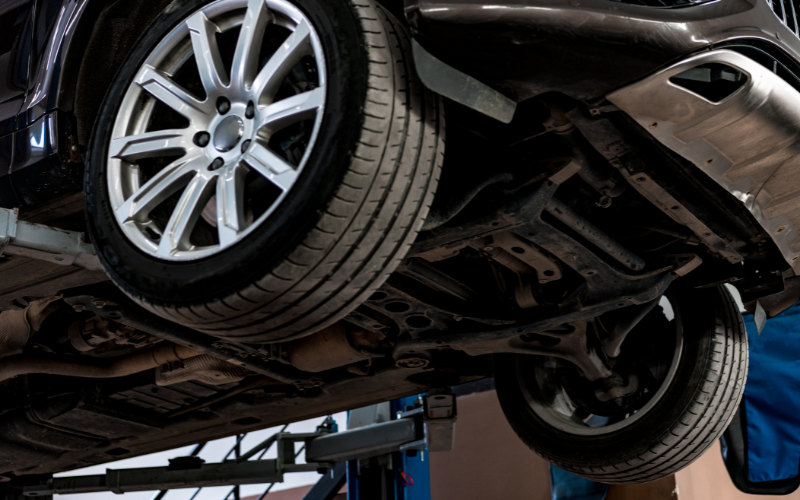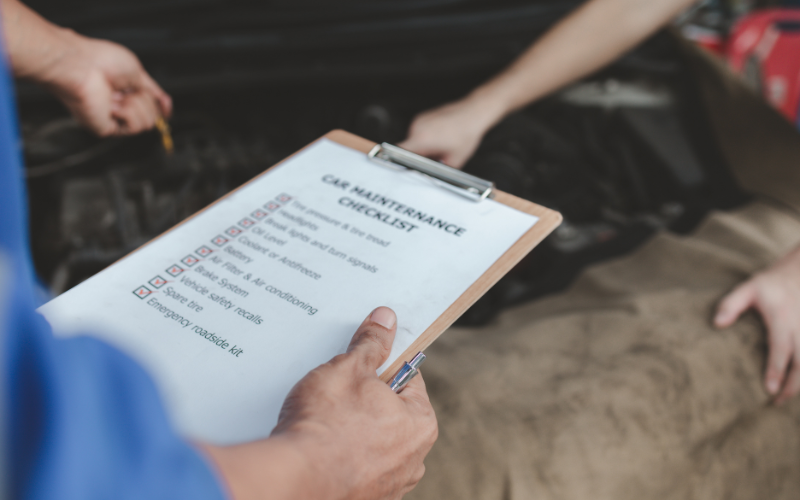MOTs Explained: Everything You Need to Know About Your MOT
17/05/2024 09:53
Share

MOTs Explained: Everything You Need to Know About Your MOT
Learn all you need to know about MOTs, from what’s included right up to the results.
We’ve all heard of MOTs before. It’s the annual inspection that your vehicle is required to have by law to ensure it is roadworthy.
But what exactly is covered in an MOT? And what should you do based on the results? Read on for a complete rundown on MOT testing.
What is an MOT test?
Many people know what an MOT test is, but not much beyond the fact it’s a legal requirement. The acronym MOT stands for Ministry of Transport, which was the government department in charge of the test.
It was introduced back in 1960 to check vehicles meet both environmental and safety regulations. Most vehicles will have their first MOT test when they turn three years old, followed by a test once a year.
How much does an MOT cost?
Costs for MOT tests vary depending on the type of vehicle, though the government sets out a maximum charge for each of these.
Cars will be charged a maximum of £54.85, while standard motorcycles will be charged up to £29.65. You won’t have to pay any VAT.
Whether you drive a car, van, motorcycle, or another vehicle, it can be helpful to know your MOT costs in advance. You can view a helpful breakdown of MOT prices per vehicle type via the government’s website.
Service plans are a great way to help you plan ahead, where you can contribute a small amount each month to cover your service and MOT. On the day, you’ll only need to pay for any repairs needed.
How does an MOT work?
An MOT differs from servicing, in that it doesn’t check the general mechanical condition of the vehicle.
Instead, the MOT focuses on checking specific components of your vehicle to make sure it remains in good condition.
For cars, these include the:
- Fuel system.
- Steering and suspension.
- Windscreen wipers and washer system.
- Windscreen.
- Electrical wiring and battery.
- Lights.
- Registration plates.
- Bonnet.
- Tyres, wheels, and Tyre Pressure Monitoring System (TPMS).
- Brakes.
- Horn.
- Exhaust system.
- Mirrors.
- Doors.
- Emissions.
- Towbar.
- Boot/tailgate.
- Seats.
- Body/vehicle structure.
The test does not cover your engine, clutch, or gearbox. Learn more about the different car parts checked during an MOT.

For motorcycles, the following parts are checked in an MOT:
- Seat.
- Fuel system.
- Horn.
- Clutch lever.
- Frame number.
- Throttle.
- Lights.
- Steering and suspension.
- Brakes.
- Wheels and tyres.
- Footrest.
- Frame.
- Drive chain and sprocket.
- Exhaust systems.
- Wheel alignment.
- Registration plates.
- Sidecars (if fitted).
Again, the test doesn’t cover the condition of your engine, clutch, or gearbox. You can read more about motorcycle parts tested in an MOT for more information. The government’s MOT guide and inspection manuals will give you a full list of everything tested.
As for the duration, the test normally takes between 45 minutes to one hour. When you bring your vehicle in for an MOT at Bristol Street Motors, you can choose to wait in our comfortable customer lounge. Here, you’ll find complimentary Wi-Fi and refreshments to keep you entertained!
What do you need to pass an MOT?
It’s hard to guarantee that your vehicle will pass its MOT every time. Wear and tear often means that sometimes there may be some issues that crop up.
You can give your vehicle a better chance of passing its MOT with a little preparation. This includes:
1. Checking your windscreen wipers – make sure they are in good condition and replace them if not. Yes, faulty windscreen wipers can result in an MOT failure!
2. Make sure all your lights are working – turn on your vehicle and check all the lights are working. Ask a family member to help with ones like brake lights or use a reflective surface such as a window.
3. Check your tread depth – this one you should be checking frequently, not just before MOT time. Using a 20p coin, check to see whether your tyres remain within the legal tread depth limit. Unsafe tyres can land you with a £2,500 fine per tyre and points on your license!
4. Top up your fluid levels – this will normally be done during a service, but if you’re already giving your vehicle a good pre-MOT prep, then you might as well.
5. Clean your vehicle – make sure that your number plates are clean and easy to read, otherwise this could make your vehicle less likely to pass the test.
6. Provide any paperwork/items needed – examiners will need your vehicle logbook and any locking wheel nuts to remove alloys for the MOT.
It goes without saying, but you should also make sure the inside of your vehicle is clean and tidy. Examiners can actually refuse to test a vehicle if it’s been extremely neglected!
MOT test results
Any defects identified during an MOT fall into one of three categories. These are dangerous, major, or minor.
If your vehicle is found to have any dangerous or major faults, it will fail the test. You’ll be given a VT30 form to document this, and you won’t be able to drive it with any dangerous faults. Major faults will need to be repaired as soon as possible.
Minor and advisory defects are small issues that are unlikely to affect the safety of your vehicle right away. You can still pass an MOT with these, though it’s recommended to have these issues corrected in good time before they become worse.
Other terminology used in an MOT includes nearside and offside. If an issue is found on your nearside (sometimes recorded as ‘N/S’), this means the left side. For example, a nearside tyre on the left may need changing. Offside refers to the driver’s side of the vehicle on the right.
When getting your MOT test results, you’ll see all your vehicle’s components listed with either a red, amber, or green light. Anything in red will need to be repaired immediately, while anything in amber is considered an advisory. Anything in green is not considered an issue.
It’s up to you which issues you have repaired on the day, other than the compulsory red ones. Viewing your vehicle health report sent by the technician will help you decide which advisories to correct now or later.
Common MOT failures
To help you prepare for your MOT, it can be useful to know some of the most common MOT failures. These include:
- Lighting and signalling issues.
- Suspension faults.
- Brake system failures.
- Tyre conditions.
- Driver visibility problems.
- Structural integrity and bodywork.
- Fuel and exhaust emissions.
- Steering system issues.
- Seat belts and restraint systems.
- Other items (e.g. a faulty horn, missing or damaged mirrors, any unexplained warning lights)
What’s included with an MOT at Bristol Street Motors?
Our manufacturer-trained technicians will ensure the best care for your vehicle during its MOT. You’ll receive a free Vehicle Health Check video and written report, plus a complimentary wash and vacuum.
We’ll check all our manufacturer systems for any outstanding recalls for added peace of mind. Plus, any repairs will be completed to the highest of standards using genuine manufacturer parts and the latest tools.
If your vehicle isn’t due an MOT, we also offer servicing and repairs, tyre checks, seasonal checks, and more to take care of all your motoring needs.
MOT FAQs
1. How can I find out when my car’s MOT is due?
You can find out when your car’s MOT is due by visiting the government website. Simply enter your car’s registration to check its MOT status and when it expires.
2. How long is the grace period for an MOT?
There’s a common misconception that there is a grace period where you can continue to drive your car after its MOT has expired. But this is not the case.
After your MOT runs out, you can’t drive the car as you could be prosecuted and invalidate your car insurance. If you need an MOT retest or repair, you can drive the car directly to the garage.
3. What happens if you miss your MOT?
It’s vital not to miss your MOT as you could face a fine of up to £1,000 for driving a car with an invalid MOT. The government website allows you to set up free text or email MOT reminders , so you don’t find yourself in a sticky situation.
4. Can I tax my car without an MOT certificate?
No – it’s illegal to tax your car without a valid MOT certificate and you put yourself at risk of invalidating your car insurance. However, there are as few exemptions.
You can tax a car without an MOT if:
- Your vehicle is less than three years old
- Your vehicle is exempt from MOTs
- Your vehicle is more than 40 years old and has classic car tax exemption
Book your MOT with Bristol Street Motors
We hope you’ve enjoyed this article and feel ready to make sure your vehicle doesn’t disappoint during your next one.
Due an upcoming MOT? You can book an MOT at your local Bristol Street Motors dealership online in minutes. If you have any questions, get in touch with our customer service team, who are available seven days a week to help.
Book an MOT
Related Articles:
How Long Does an Mot Take
Top 5 MOT Failures and How to Avoid Them
Everything You Need to Know About Car Tax: Car Tax Bands Explained